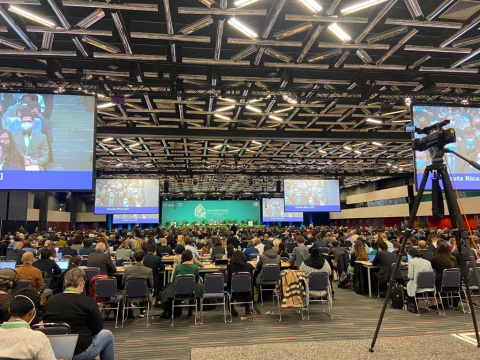Submitted by Laura Dunn on

As newspaper headlines that warn of the increasing numbers of animal and plant life facing extinction become ever more urgent, delegates have begun to trickle into the Palais de Congres in downtown Montreal for the COP 15 global biodiversity summit under the Convention on Biological Diversity (CBD). The building is cordoned off on all sides by an astonishing number of police guarding the streets and patrolling on bike, cars and horseback. The security operation is said to be the largest the city has seen in 20 years. Entering the sprawling building feels akin to boarding a plane, complete with mandatory security checks and self-administered Covid tests. This iteration of the COP is an especially important one, with delegates set to negotiate over a framework text, the Global Biodiversity Framework, which will ostensibly govern the Earth’s biodiversity over the next decades, and which addresses a range of key issues, from pollution and protected areas, to invasive species and agriculture.
Inside the building, adorned with gaudy signs and messages like 'nature-positive' and 'living in harmony with nature', the hallways are so far largely quiet and the conference and media rooms are filled with only a handful of people before COP 15 gets into full swing and thousands more people arrive - many of them ‘COP-hoppers’ still sporting their suntans from Sharm el Sheikh’s recent COP 27 climate summit. These few early days, before the ‘tourists’ arrive, are dedicated to the Open-Ended Working Group (OEWG), a series of preliminary negotiations that take place before the official COP 15. Although not so well known, these meetings are fundamental to the upcoming days of negotiations: they are where the more hardcore and experienced delegates are already haggling over the scope of issues that will be negotiated over the next two weeks. Already, the text of the Global Biodiversity Framework is written in draft form, mostly as a series of targets to achieve in the coming decade (the current text has over twenty of them).
A coalition of civil society groups, including ETC Group, are concerned with a particular handful of these targets, and how they will be reflected in the text to be negotiated December, 7-19. These include Targets 6, 10 and 17 and a crucial mismash of text called 'b-bis'.
Target 6
In Target 6, civil society groups are calling for the framework text to recognize the importance of traditional and indigenous knowledge and indigenous technologies. The language of Target 6 is concerned with invasive species. The techno-lobbyists want to promote “innovations and new tools” such as gene drives to target invasive species, but do not acknowledge the importance of proven innovation of IPLCs (indigenous people and local communities).
Target 10
Target 10 has to do with agriculture, and its negotiation will pit countries that wish to deepen and expand corporate and industrial agriculture against those that wish to embrace agricultural biodiversity and agroecology. Groups like the African Centre for Biodiversity would like Target 10 to include language that reflects the importance of agroecology and the rights of small farmers. In an encouraging groundswell of support a number of countries such as Bolivia, EU, Norway, Peru and Egypt have insisted that agroecology be part of this crucial target. In retalliation, agribusiness-friendly nations such as Brazil and Argentina are trying to pepper the text with biotechnology, and “climate smart” and "sustainable intensification” buzzwords.
Target 17
Target 17 reflects an issue fundamental to new technologies and in particular to biotechnology. From its very inception, the CBD has adopted a precautionary approach to new technologies which has allowed parties to create regulations, rules and sometimes moratoria on technologies such as GMOs, genetically modified trees and gene drives. Such approaches have been fundamental to the well-being of countries and their biodiversity, providing an important means to scan, assess and monitor risky and dangerous new technologies. Target 17 has horizon scanning, technology assessment and the monitoring of new and emerging technologies within square brackets; this means that these precautionary approaches are not yet set in the text. Civil society groups are lobbying for these brackets to be removed to safeguard a precautionary approach to new technologies. This is especially important when it comes to new developments in synthetic biology such as gene drives. Citizens of Burkina Faso, Uganda and Tanzania who are present at this COP 15 are especially concerned about the risky impacts of gene drives on biodiversity in their countries.
As the official COP begins in the next few days, civil society groups hope that these key elements survive through to the final text. This will be important not only for the final text that comes out of these negotiations, but for the future of biodiversity on the planet over the next decade.
